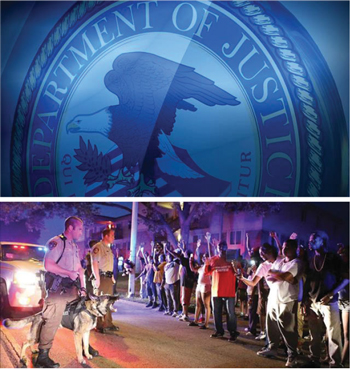Justice Dept. documents more Ferguson failures
By J.A. Salaam -Staff Writer- | Last updated: Sep 8, 2015 - 11:22:30 AMWhat's your opinion on this article?
FERGUSON, Mo. (FinalCall.com) - The Department of Justice recently released a report on the Ferguson police department showing violations they received weeks after the fatal shooting of 18-year-old Michael Brown Jr. last fall. This report is not connected to the previous one that criticized Ferguson’s police practices and the city’s municipal court system in March earlier this year.

Police face off with demonstrators in Ferguson, Mo., after the fatal shooting of 18-year-old Michael Brown. Photo: MGN Online
|
The errors included a “five second order” which forced protestors to keep moving after five seconds, the use of armored vehicles to control and fire tear gas projectiles on the crowd, snipers on buildings, officers not wearing name badges and having police K-9 units with attack dogs chase peaceful demonstrators.
The Justice Dept. called the use of canines for crowd control in Ferguson an “inappropriate and ineffective strategy.”
Another problem outlined in the Justice Dept. report was bad communication and mixed instructions given to officers when several municipalities were dispatched to assist Ferguson police with protestors. The situation worsened because there was confusion among officers not knowing who was in charge when orders were given, the Justice Dept. found. The report said the Ferguson Police Department had virtually no community relationship with residents in the Canfield Green Apartment complex where unarmed Brown was killed by White former Ferguson police officer Darren Wilson.
Following its assessment of law enforcement agencies and citizens, the Justice Department said: “Having effective relations and communications with the community, recognizing that endemic problems were at the base of the demonstrations, and understanding how the character of the mass gatherings was evolving and spreading beyond the initial officer-involved shooting would have all aided in incident management decisions.”
What happened in Ferguson is not isolated to that geographical area of St. Louis County, but reflects growing tension between Black communities and police departments across America. Law enforcement officials have cited the recent killings of law enforcement officers outside Houston and in a Chicago suburb as examples of the hazards of the job. The killing of a Harris County Sheriff’s deputy was blamed on the Black Lives Matter movement and anti-police brutality protests without any connection and despite the accused shooter, who was Black, having a history of mental problems.
The killings have helped fuel an atmosphere of fear, anger and distrust between police and Blacks, who are disproportionate victims of police brutality and police killings. Since the shooting death of Michael Brown Jr., other unarmed Black men have been shot and killed by police and others, including Sandra Bland in Texas, Freddie Gray in Baltimore, Walter Scott in South Carolina and 18-year-old Mansur Ball-Bey in St. Louis, died following encounters with police.

Family members of Mansur Ball-Bey sing an emotionally charged rendition of ‘Stand’ to the family and friends. His cousin Rosalind Coty Veasley in white
|
“He was a good young man; he didn’t sag his pants; he didn’t have tattoos; no earrings in his ears; he was always respectful and willing to help others; he had a good name … will you leave here with a good name?” asked his cousin Rosalind Coty-Veasley.

Mansur Ball-Bey’s Family listen as speakers share thoughts.
|
“As Attorney Jermaine and I started investigating what they said happened, it didn’t make sense things began to unravel. The Bible said faith without works is dead. We are going to continue to work aggressively to make sure that justice is met in this case,” said Attorney Jeryl Christmas.
Police said the teenager was shot to death by police who were trying to execute a search warrant. Authorities claimed the young Black male ran, turned, pointed a gun at officers and was shot to death by police. An autopsy showed he was shot in the back. An investigation into the shooting death is underway.
The entire region has continued to mourn the deaths of Blacks at the hands of police officers or one another. People are seeking solutions in a seemingly unending battle.
Last year after the death of Michael Brown Jr., Missouri Governor Jay Nixon organized a group of 16 men and women from diverse backgrounds as the Ferguson Commission. Its assignment was to investigate and interact with residents of Ferguson and surrounding communities to determine what caused problems between the majority White police force, the White-dominated government and a 67 percent Black population. The commission will make recommendations about what can be done to help solve the problems. The commission is scheduled to give a public report of its findings on Sept. 15.
INSIDE STORIES AND REVIEWS
-
-
About Harriett ... and the Negro Hollywood Road Show
By Rabiah Muhammad, Guest Columnist » Full Story -
Skepticism greets Jay-Z, NFL talk of inspiring change
By Bryan 18X Crawford and Richard B. Muhammad The Final Call Newspaper @TheFinalCall » Full Story -
The painful problem of Black girls and suicide
By Charlene Muhammad -National Correspondent- » Full Story -
Exploitation of Innocence - Report: Perceptions, policies hurting Black girls
By Charlene Muhammad -National Correspondent- » Full Story -
Big Ballin: Big ideas fuel a father’s Big Baller Brand and brash business sense
By Bryan Crawford -Contributing Writer- » Full Story






 Click Here Stay Connected!
Click Here Stay Connected!








